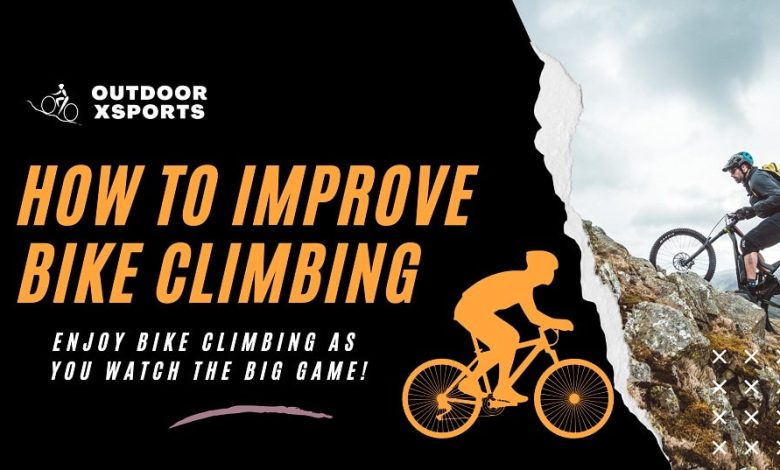How to improve bike climbing?

Love or hate climbs are an important part of almost every type of cycling. Find out what you can do to improve your skill and climb like a pro. With the big wheel mongoose bike, you can easily climb mountain riding. In this article, we share the best tips to climb more efficiently and comfortably.
1. Learn when to pedal on the saddle and when to stand on the pedals
In addition to generating harmonious pedaling, our posture on the bike is essential to improve our climbing technique. Some say that it is better to climb on the saddle and some think that the best way is to do it standing on the pedals.
Both styles of pedaling work different muscle groups and have certain advantages over each other. The ideal is to alternate the two techniques during prolonged climbs, taking into account your comfort and the dosage of your energy.
Characteristics of pedaling on the saddle
This is the most efficient way to go up. It is ideal for dosing your effort, it allows you to work with different groups of muscles, and it allows you to reserve your energy to prepare for the attack.
When climbing on the saddle, it is recommended to use a cadence that allows you to continue advancing at a good speed without exerting excessive effort. The cadence is usually higher than what you would take when riding flat.
The position of the arms plays an important role in pedaling on the saddle. What you have to do is keep your elbows and wrists relaxed, as well as not squeeze the handlebars too hard. In this way, you save energy and can breathe more efficiently during climbs.
Similarly, avoid moving on the saddle. This will waste useful energy to keep climbing. When pedaling on the saddle, focus on pedaling with your legs. Remember, the torso and arms should be relaxed.
This posture is good for the long ascent. However, it is not efficient in attack.
Pedaling characteristics on the pedals
Standing on the pedals is a technique that is preferable to use in short segments with a higher degree of ascent. With this posture, you will be able to generate greater force in your pedaling, which translates into greater ascent speed.
When getting up from the saddle, it is advisable to do so with a slight incline towards the front of the handlebar to maintain good traction with the front wheel.
Keep your hands on the ends of the handlebars. If your bike uses drop bars, these should go over the hoods. This position will help you maintain a better balance when applying the classic movement known as the “ballerina.”
As it is a posture that requires more physical effort, it is not advisable to abuse it. It is recommended to use it for short periods and with steeper slopes.
Both techniques have their advantages and disadvantages. Also, not all people are the same. Some are more comfortable using one technique over the other. The final decision is yours. Experiment with which one you feel most comfortable with at different points of the climb.
2. Find your optimal cadence
Cadence is defined as the number of revolutions per minute (rpm) that the cranks give when pedaling. Before talking about an “optimal cadence” for climbing, we must be aware that there is no universal value. Each person is different and depending on the physical condition, degree of slope, effort, level of fatigue, and even their taste, each person will have their ideal cadence.
A good starting point to find your ideal cadence will be around 80-100 rpm. The most accurate way to obtain this measurement is with a cadence sensor connected to your cycling computer. Alternatively, focus on your cadence and try to identify the point where you make the most progress without trying too hard.
3. Dose your effort along the route
Do your effort and don’t burn yourself from the start. A fairly common mistake is to start the climb with everything and run out of fuel long before finishing the ride.
If you do not know the route, it is best to start at a pace that allows you to maintain a comfortable cadence, keep a good breath, and that you know you can sustain for long periods.
Increase the pace only when the route demands it. Today, technology allows us to give us an idea of the conditions of the terrain, so it does not hurt to study the route to give you a better idea of what awaits you.
If you already know the route, follow the same principle. It starts slow, at a comfortable pace that you can maintain throughout the journey. By knowing the route, you will be able to consciously determine in which segments you can increase the pace and where to recover.
Climbing is also mentally demanding. If you shoot in a group, take it as a personal challenge. Don’t worry about keeping up with other people. Focus on your cadence, breathing, and maintaining your energy level. Consider that what will help you improve your time is to increase your average speed.
4. Select the appropriate gear ratio
Making changes promptly and proper selection of development is essential to improve escalation. For this, it is important to understand how the bicycle gears work.
Choosing the right ratio has to do with your physical condition, degree of slope, and even the components your bike is equipped with. But in general, what is sought is to maintain an adequate cadence.
Another important factor is knowing when to make changes. Ideally, anticipate the change in speed to the degree of the slope. If the change is too early, you will miss some of the inertia that you already have. On the contrary, if you make the change too late you will have to make a greater effort or in extreme cases, it will even be impossible to pedal.
5. Balance your weight to maintain traction
The change of slope affects the distribution of our weight on the surface of the ground. This, in turn, results in a decrease in traction. That is why it is important to balance our weight back and forth on the bike to compensate for this loss of traction.
If, when pedaling on the pedals, you notice that you lose traction on the rear wheel, you will have to shift your weight backward or even sit on the saddle. Conversely, if you lose traction with the front wheel, you will need to shift your weight to the front of the bike.
7. Maintain good hydration and nutrition
It is important to stay well hydrated. Try to take small sips of water frequently, even if you are not thirsty. If you start to feel thirsty during your climb, it is a sign that you are already dehydrated.
Also, try to eat at least every hour during your route. It can be nuts, cereal bars, or something with carbohydrates, which will provide you with the fuel you need to attack that slope.
8. Practice the climbs regularly
There is no better way to progress your climbing than by practicing. Training on steep slopes not only helps you improve your physical condition but also strengthens your legs. In addition, you will have the opportunity to improve your technique, find your cadence, and perfect the choice of the speed ratio in good time.
Facing these challenges also helps you exercise your mind. You will learn to dose your effort and you will know how long you can sustain high levels of effort.
In addition to the outings, it is also advisable to train on a roller. These allow you to focus more on your technique and super specific workouts in a controlled environment. Also, times have changed and now you can combine the roller with indoor cycling apps and make it more fun.
9. Determine your healthy weight and maintain it
The weight ratio or proportion of weight is very important to improve climbing in cycling. The heavier you are, the more strength and energy you will need. Therefore, if you are overweight, your ascent speed will also decrease.
10. Reduce the weight of your bike
This is the most expensive way to improve your climbing. It’s simple physics. The less weight, the faster you can climb. Some of the components where you can save the most weight are the tires and the wheels themselves.
Other slightly more expensive alternatives will be to invest in higher-end components such as gearbox, Seatpost, or handlebar. You might even consider investing in a new bike.
Put these recommendations into practice and you will notice the difference immediately. Don’t take each start as a race. Focus on your technique, cadence, and your breathing. Do not be afraid of the rises. Learn to suffer rich and enjoy.




